Montpellier have been earning some not-so-impressive results early in the season. Michel Der Zakarian’s side lost their opening Ligue 1 game against Rennes before drawing in the next one against Bordeaux. Montpellier didn’t play so badly but still looked a bit unconvincing in their first two games.
The Southern France-based club had to face a strong Lyon side who were full of confidence and vigour, fresh after a thumping 6-0 win against Angers and prior to that, a convincing 3-0 victory against Monaco. Sylvinho’s side have been very aggressive in attack and impressively solid in defence. The two clean sheets, as well as nine goals out of two games, are clear evidence that Lyon are a side to be feared this season.
However, as it turned out, Montpellier were well-prepared and dealt with their opponents accordingly. Lyon were neutralised by the persistent and excellently-organised Montpellier in this game.
We’ll take a deeper look at how both teams fared against each other in this tactical analysis.
Lineups
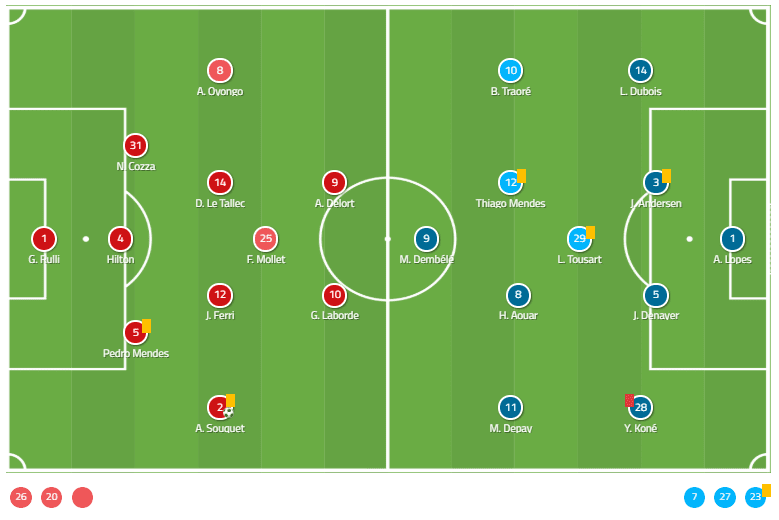
Montpellier (3-4-1-2)
Der Zakarian’s preferred shape never really strays far from 3-4-1-2 or 5-3-2. After deploying his team in a 5-3-2 shape in their last two games, the Franco-Armenian manager decided to play with a 3-4-1-2 system in this game.
Only two changes were made in terms of personnel for this game. Advanced playmaker Florent Mollet returned from injury to start in this game ahead of Mihailo Ristic. Meanwhile, highly-talented centre-back Nicolas Cozza made his first start for Montpellier this season ahead of a more experienced Daniel Congré.
Starting XI: Rulli – Mendes, Hilton, Cozza – Souquet, Ferri, Le Tallec, Oyongo – Mollet – Laborde, Delort
Bench: Bertaud, Ristic, Suarez, Chotard, Dolly, Camara, Skuletic
Coach: Michel Der Zakarian
Lyon (4-1-4-1)
Sylvinho has been extremely successful with his high-intensity 4-1-4-1 (or 4-3-3) system in their last two matches, racking up huge wins in those two. The Brazil-born tactician used the same tactics again in this game.
No changes at all were made in this game in terms of personnel. Sylvinho seemed quite confident with his team and system.
Starting XI: Lopes – Dubois, Andersen, Denayer, Koné – Tousart – Traoré, Mendes, Aouar, Depay – Dembele
Bench: Tatarusanu, Marcelo, Tete, Reine-Adelaide, Lucas, Terrier, Cornet
Coach: Sylvinho
Montpellier’s well-organised defence
Der Zakarian’s side played with a moderate approach in this game. They weren’t sitting back but they weren’t too aggressive as well.
Despite playing with a 3-4-1-2 system on paper, their shape shifted into a 5-3-2 with the two wing-backs dropping deeper.
Montpellier’s five-man backline defended with a medium block. However, the wing-back would actively follow the opposing winger and immediately press them as soon as the ball was played towards their direction as you can see in the picture below.
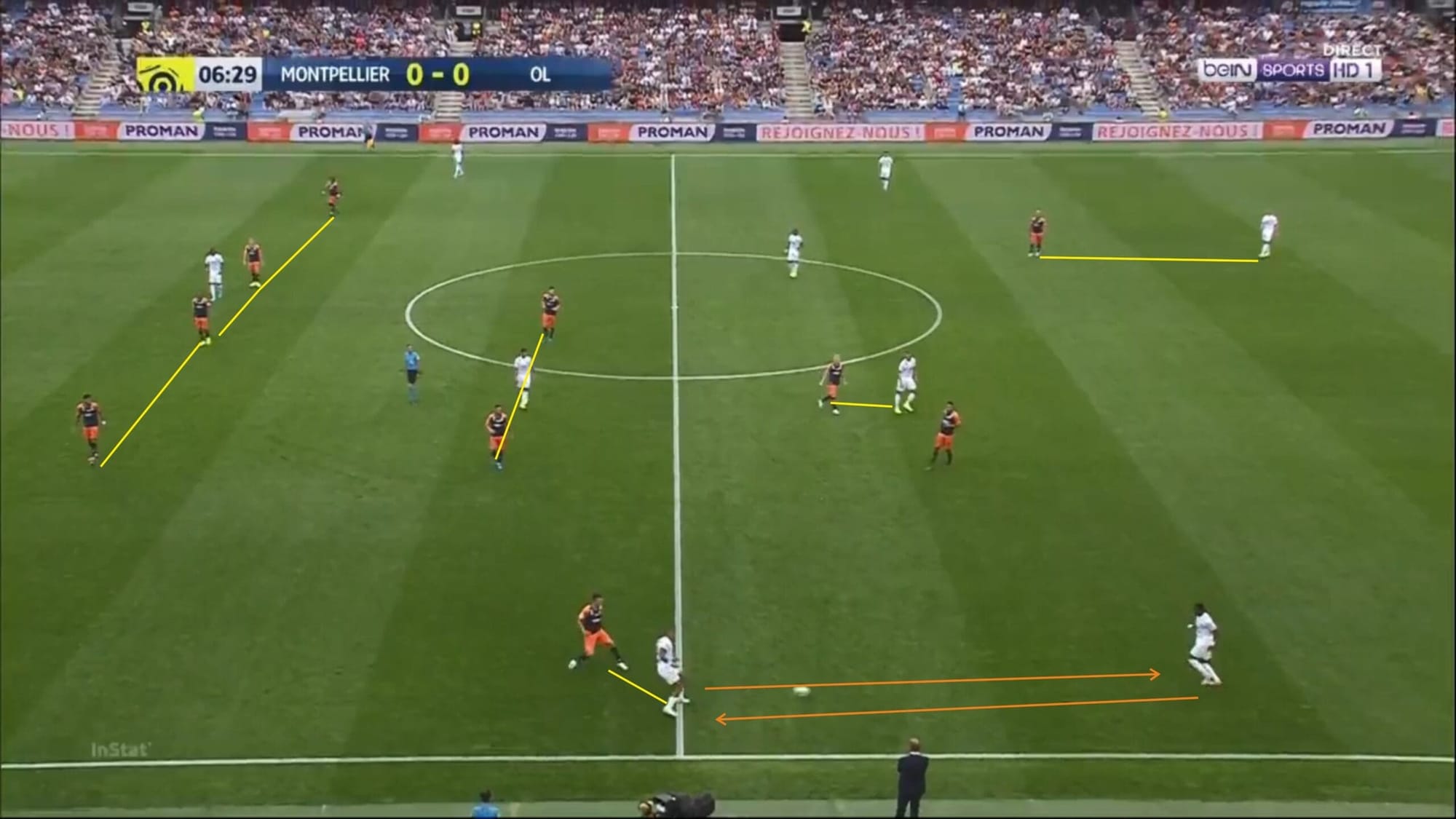
With the opposing winger (which in this case was Memphis Depay) dropping deep to receive the ball, the wing-back (Arnaud Souquet) who was part of the Montpellier’s five-man defence would follow him and be moved out of position. However, Montpellier stayed solid and organised by forming a four-man backline and still maintaining a moderate width at the back.
Lyon were having difficulties to progress the ball in this game. This was mostly due to Montpellier’s man-oriented marking and pressing – isolating the ball carrier whilst also pressuring him into making a mistake.
Montpellier didn’t seem to press the centre-back when Lyon were in their initial build-up phase. However, Montpellier would block their path of progression via man-oriented marking, allowing only lateral passes to be played. When a pass was played to the full-back, Montpellier’s striker (Gaetan Laborde/Andy Delort) would try to close down the ball carrier while also positioning himself in such a way that he could block his passing lane back to the centre-half which effectively isolated the opposing ball carrier and putting pressure on him as well.
Florent Mollet also seemed to mark Lucas Tousart tightly in this game as you can see in the picture above. Though known mostly for his defensive prowess, Tousart also offers the ability to distribute the ball well, however, he was given no chance at all to hold the ball as he was tightly marked and always followed around by Mollet.
Though defending with a medium block, Montpellier would immediately move up and press when the opposition was seen making a mistake or when the opposing player’s touch was heavy to put them in an even more uncomfortable position.
Montpellier also tried to press after losing possession. This was, of course, to win the ball back from as high up the pitch as possible or if that didn’t happen, at least they could slow down their opposition in their transition to attack or even destroy their momentum by committing a tactical foul if needed.
Building up and breaking through Lyon’s defence
There were some similarities in Lyon’s and Montpellier’s defensive tactics although there were several clear differences.
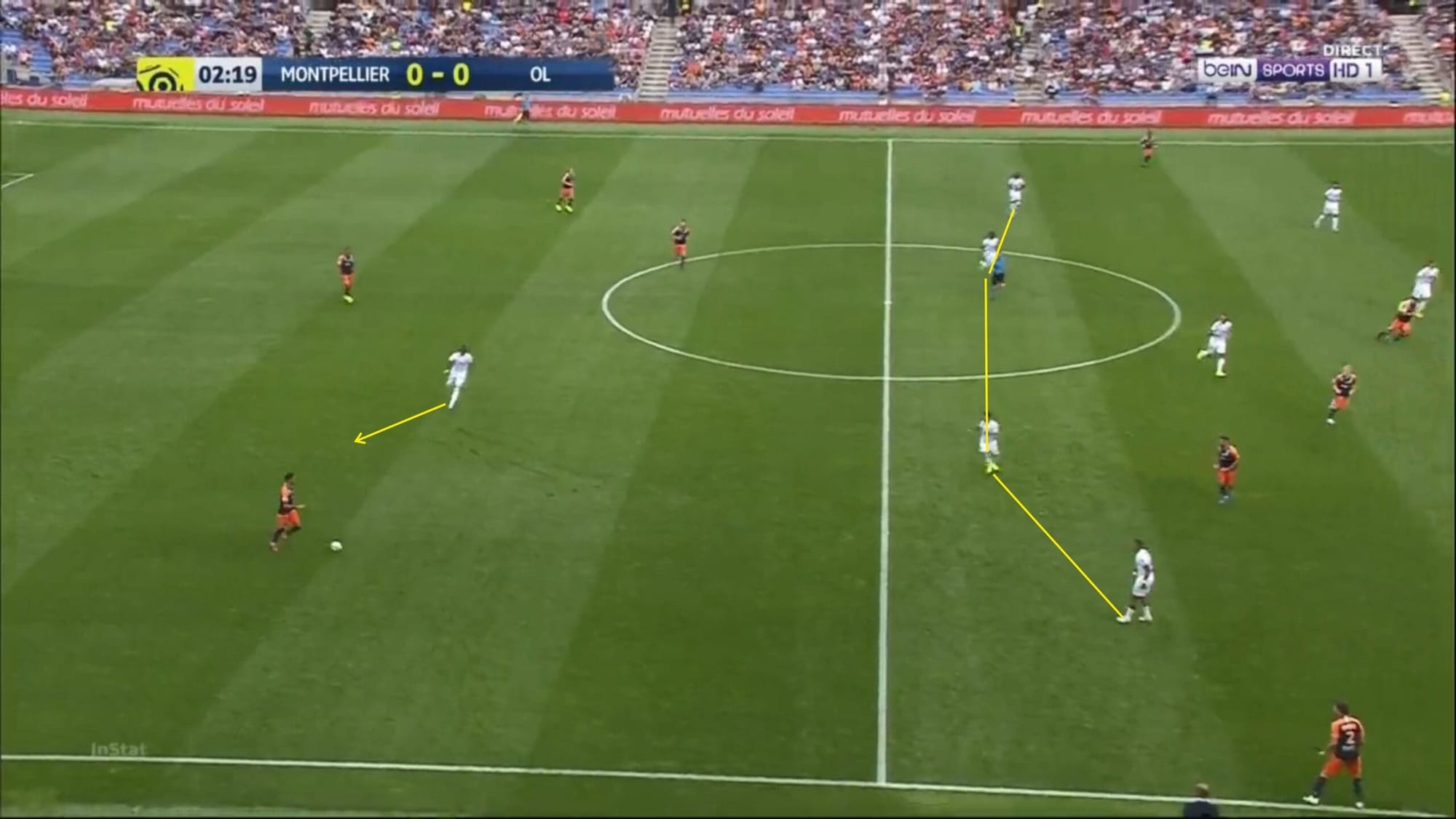
Just like Montpellier, Lyon also defended with a medium block.
Moussa Dembele actively gave pressure upfront. When the ball was with Vitorino Hilton, there was no pressure given. However, when the ball was played laterally to the right or left-sided centre-back, Dembele would close down the ball carrier, splitting the centre-back with his partner at the back while blocking his passing lane in an attempt to isolate him as you can see in the picture above.
Unlike Montpellier though, Lyon didn’t defend with man-oriented marking. They retained the 4-1-4-1 shape in defence, marking the opposition passing lane instead of the man.
Slyvinho’s side also tended to immediately press after losing possession, with the same aim of winning the ball high up the pitch and/or destroying the opposition’s counter-attack.
However, Montpellier’s build-up plan was effective in dismantling Lyon’s defensive organisation.
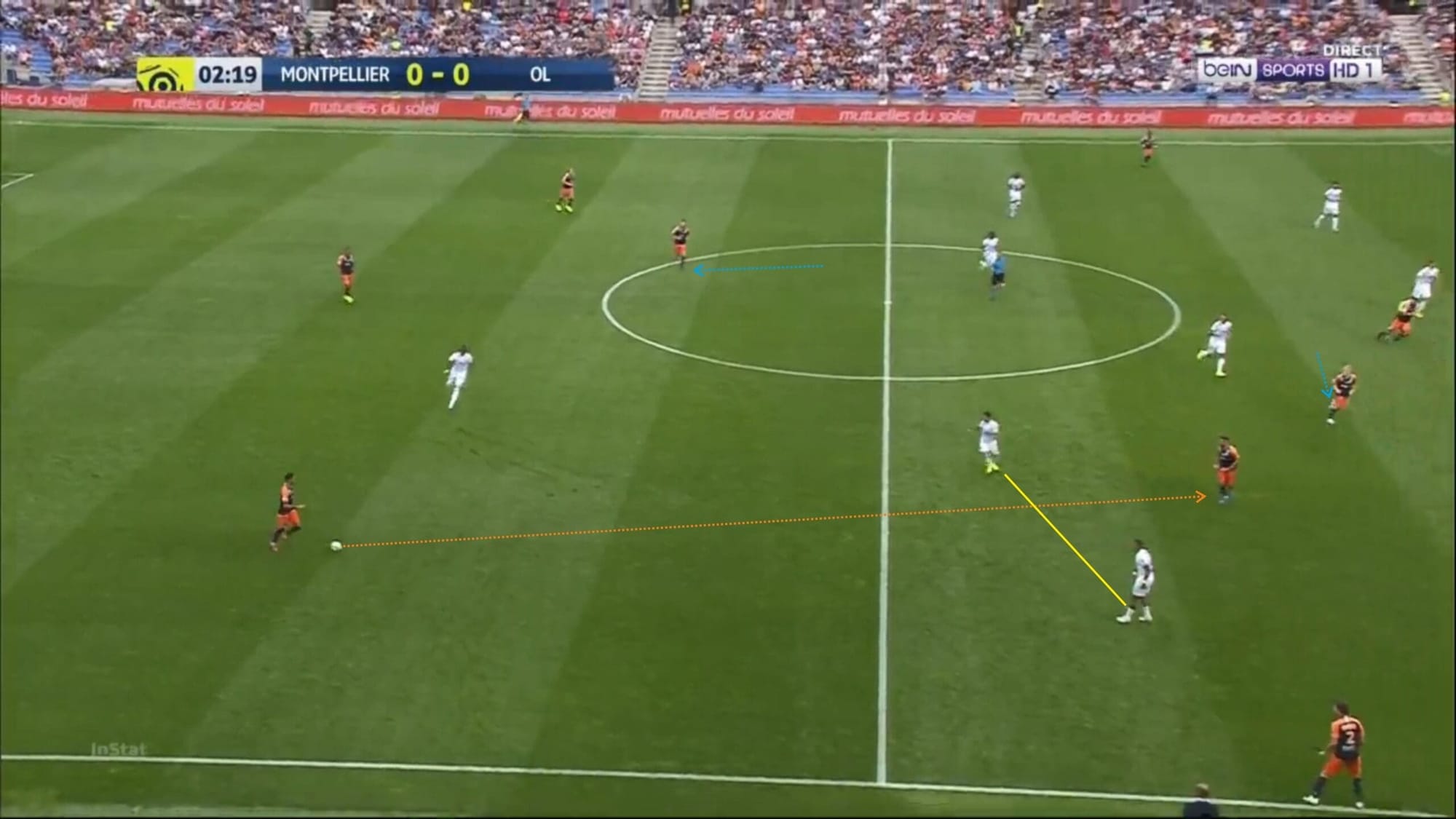
Montpellier built their play up from the back. They usually progressed through the half-wide spaces and attacked from the flanks.
As you can see in the picture above, the wing-backs already positioned themselves high even in the initial build-up phase, sitting behind the wingers and between the midfield and defensive lines. The three centre-backs tended to split and move wider with or without the ball.
There were several different tendencies in Montpellier’s players though.
Damien Le Tallec, for example, tended to drop back when in the build-up phase, while Jordan Ferri often tried to position himself in pockets of space as in the picture above. Pedro Mendes was also a bit braver in playing vertical passes, especially the ones directed to the players in the pockets of space, while Cozza often lofted the ball forward to find Delort or Ambroise Oyongo’s run out wide. The young centre-back also often gave the ball back to Hilton who also had the tendency to deliver a long lofted diagonal pass towards Oyongo in the left flank.
In the picture above, Montpellier was trying to build their play up through Mendes. In that situation, the centre-back played a perfectly-weighted ball into the feet of Ferri. You can also see from the picture that Mollet drifted wide from his central position in order to create an offensive overload in the right flank.
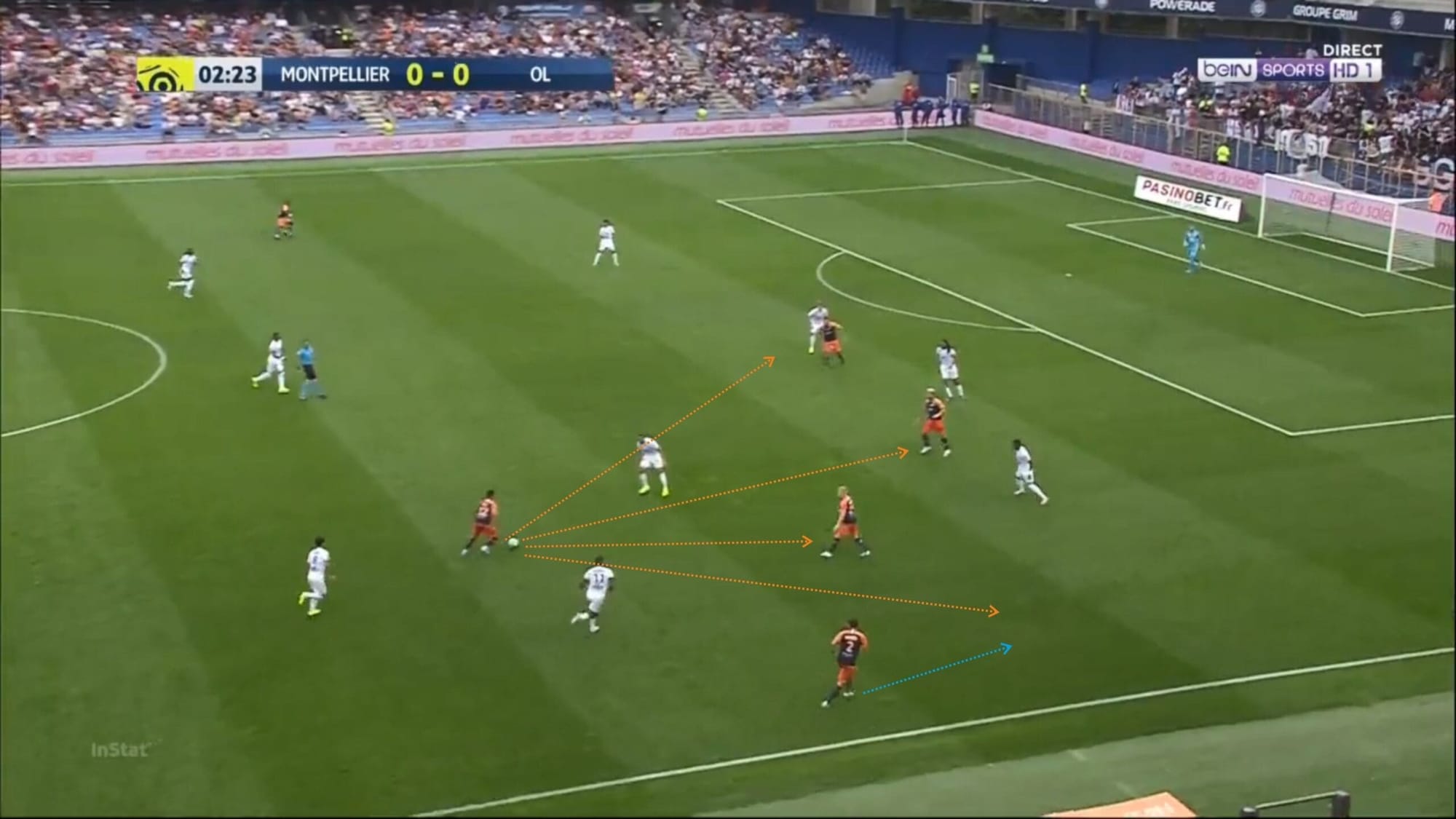
Now the picture above was when the ball’s at Ferri’s feet.
Mollet and Delort were extremely active in this game, their movements both on and off the ball were crucial and they covered a good amount of ground in the game.
In this situation, Delort left his designated position and roamed to the right side, occupying Jason Denayer while Laborde stayed central. With Arnaud Souquet making the run and Mollet free of any marker here, Ferri had several excellent options to choose from. Souquet’s run out wide created a 2v1 situation in the right flank and there’s a good chance that Koné could be overwhelmed. However, Ferri decided to pass the ball to Delort in this game which didn’t seem to be the best option possible albeit an available one.
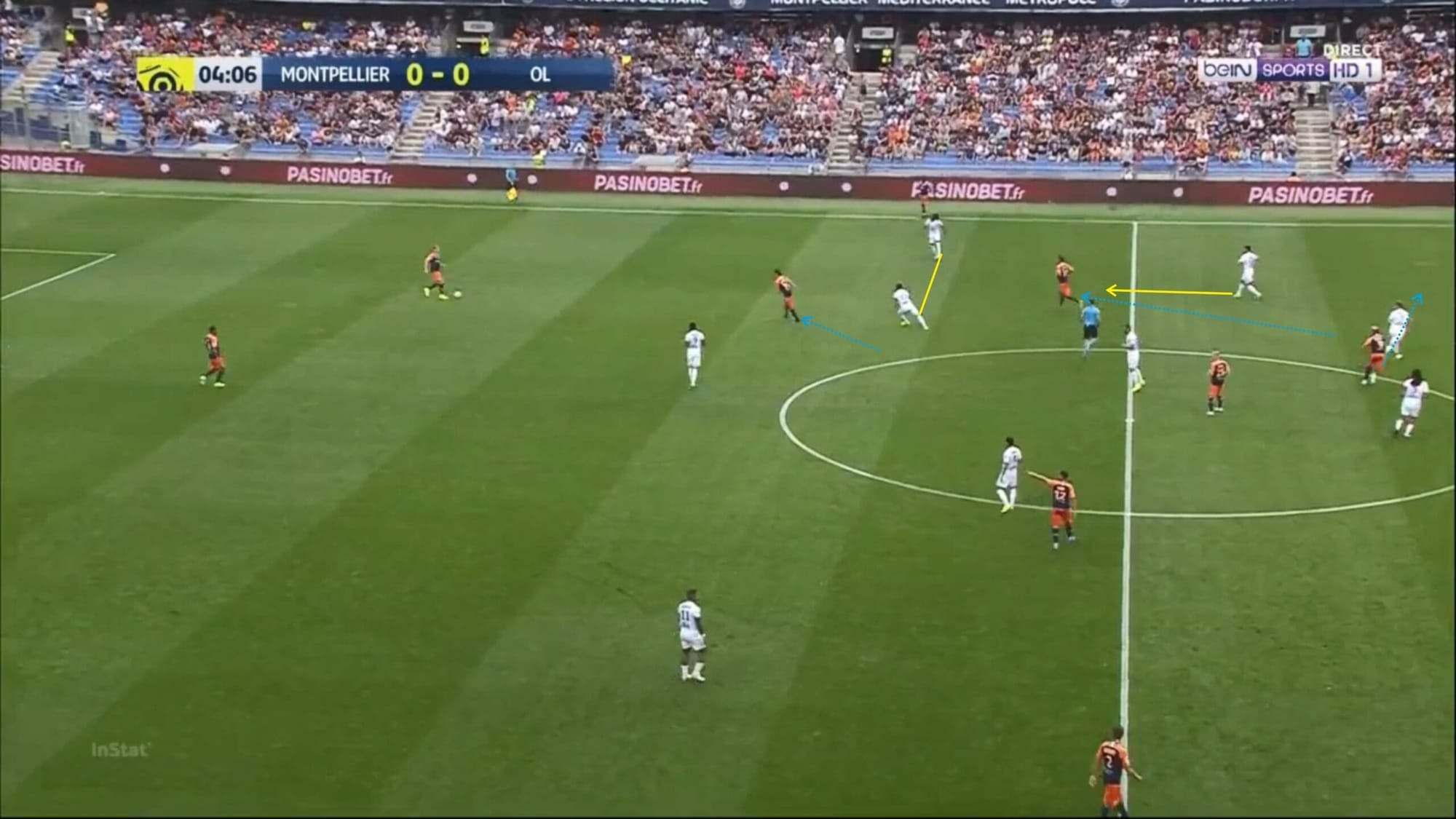
On the left side of the pitch, Montpellier’s way of attacking was a bit different. In the picture above, you can see that the ball’s currently with Cozza. Le Tallec dropped back to help link up the play. Laborde moved to the half-space, trying to find himself in a pocket of space.
In this situation, Leo Dubois saw Laborde moving into the pocket of space and kept a rather close distance with him in anticipation of if the ball’s played to him. However, Cozza rarely played the ball into the pocket of space as mentioned previously in this tactical analysis.
As Dubois moved out of position both Oyongo and Delort saw the opportunity to exploit the space in the wider area and both immediately made the run into space. Cozza then played the ball to Hilton who in turn delivered a long diagonal pass who was received by Oyongo out on the left side of the pitch as you can see in the picture below.
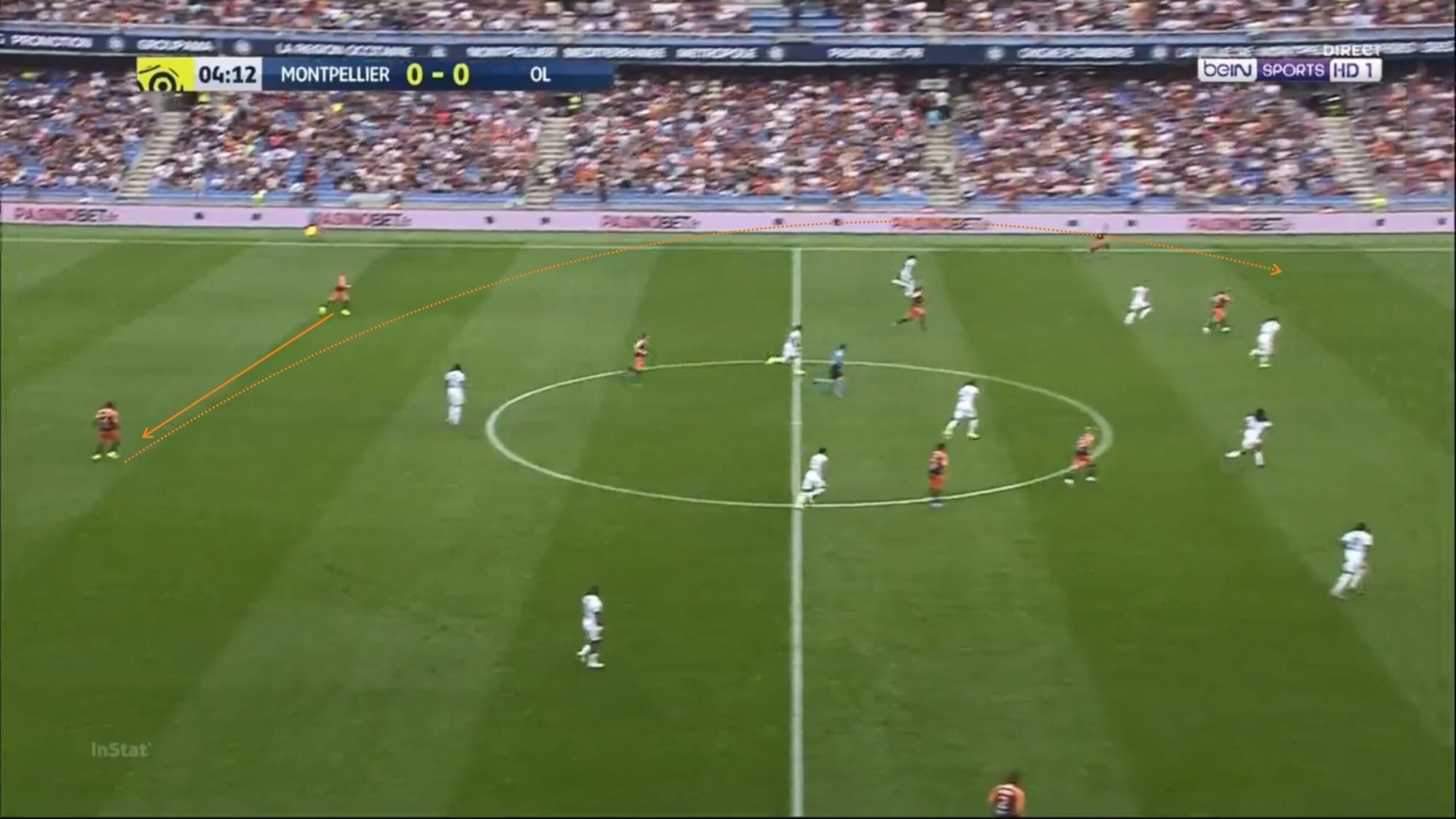
This could have been dealt with if Traoré was more aware of Oyongo’s movements out wide. Montpellier played with width and they were extremely successful in exploiting the spaces down both flanks. Creating an overload on one side of the pitch opened up spaces to be exploited. However, Montpellier could have had a more difficult time if Lyon’s wingers were more active in defence and aware of the wing-backs’ movements. They should also make themselves available to cover the wider areas in case the full-back was driven out of position. However, this was not the case in this match.
Lyon’s lack of creativity in attack
Sylvinho had his own plan for this game but as the game went on, it became quite clear that Montpellier already knew how to deal with it. Yet there didn’t seem to be many changes in terms of tactics or approach to the game from Lyon throughout the game, most notably in attack.
They seemed to go on and on, trying to use the same plan in an attack that quite clearly wouldn’t work against their opposition.
Lyon built their play up from the back. They were actually rather quick in moving the ball and once they managed to find the space to progress, they were very quick in breaking away.
They mostly exchanged quick, short, one-two touch passes in a bid to build their play up and break quickly. However, the lack of options to progress due to Montpellier’s man-oriented marking and pressing as mentioned previously in this tactical analysis forced Lyon to be slightly more patient.
Montpellier’s man-oriented marking and pressing should have been quite easy to get through if Sylvinho’s men actively rotated their position. This was something that could be seen a bit more, later in the second half with Depay, Dembele, and Houssem Aouar often swapping spots and covering each others’ positions.
However, mostly throughout the game they were all a bit too passive and lacked initiative and creativity.

From this picture again, we can see that Lyon were a bit struggling to progress. When the ball was with the centre-back the only open option was usually the full-back. When the ball was moved wide, the central options were blocked and inaccessible which forced Lyon to just combine and progress through the flanks.
Lyon mostly attacked through the right flank, with 30 of their attacks coming from the right side while around 28 came from the left, and only 17 were from the centre.
Bertrand Traoré created more chances for his teammates than for himself. The left-footed right-winger would often receive the ball wide, moving it into his favoured left foot and then crossing the ball in towards Dembele and Depay who’d usually wait inside the box for the cross. Depay, meanwhile, was a bit more focused on getting the goal himself, often cutting inside and attempting a shot rather than, like Traoré, delivering a cross from wide.
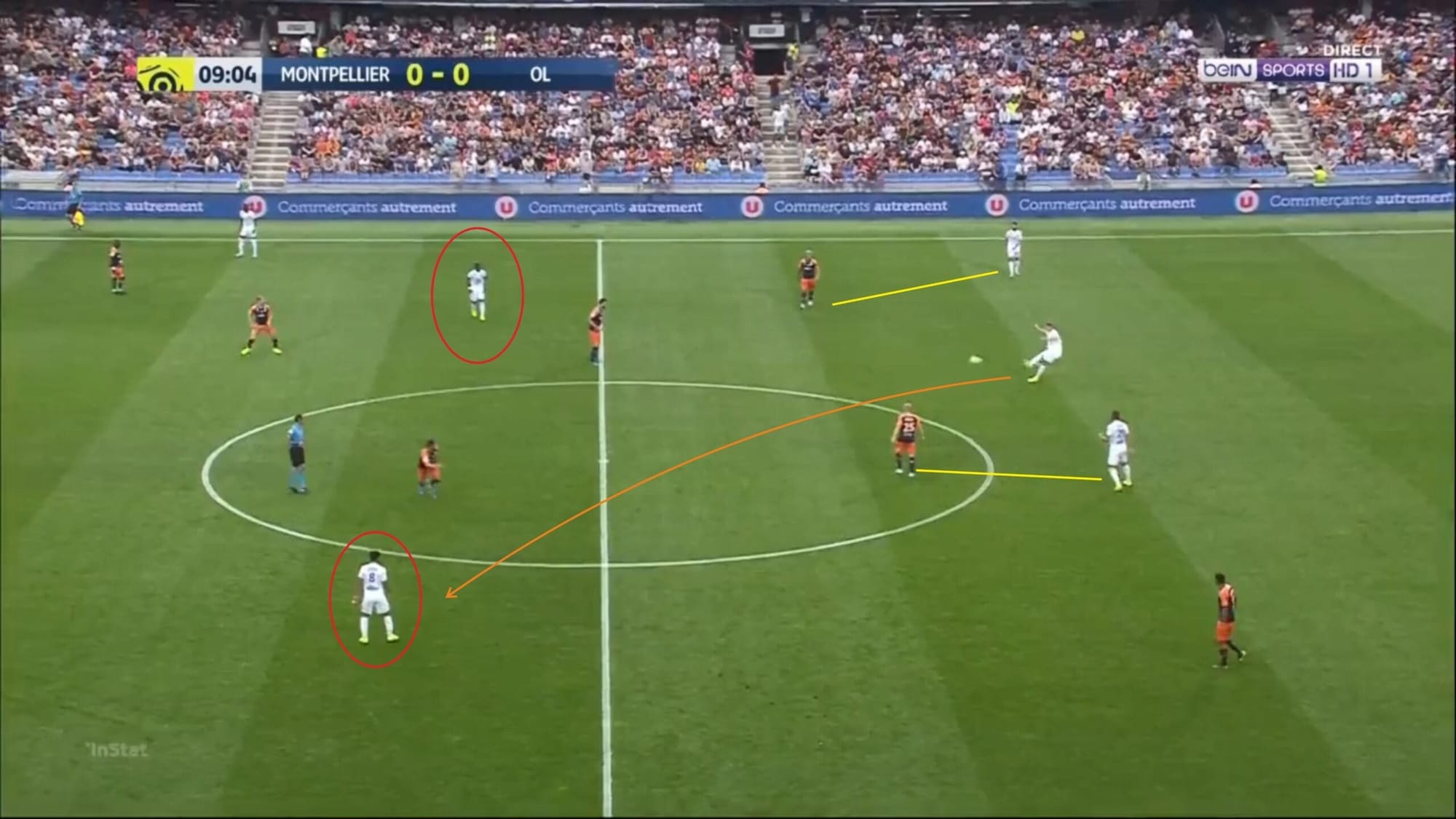
Back to the build-up again, Montpellier were successful in disrupting Lyon’s game plan right from the start. But it was also perhaps Lyon’s fault themselves that they were having difficulties against La Paillade. The lack of movement both upfront and at the back were disappointing. The forwards rarely dropped deep to link up while the defenders and the midfielders were struggling to find a teammate to pass to.
However, Lyon actually managed to bypass Montpellier’s man-oriented marking and pressing in the picture above and progressed through the middle where they were the most dangerous. In this situation, Tousart dropped back and positioned himself between the two centre-backs while Mollet followed and stayed close to him. This opened up space for Joachim Andersen to play a progressive pass.
The two centre-mids positioned themselves diagonally from the ball carrier, finding pockets of space in the middle of the field. In this situation, although the lateral options have already been blocked by Montpellier, Andersen could still play the ball diagonally towards either of the two centre-mids.
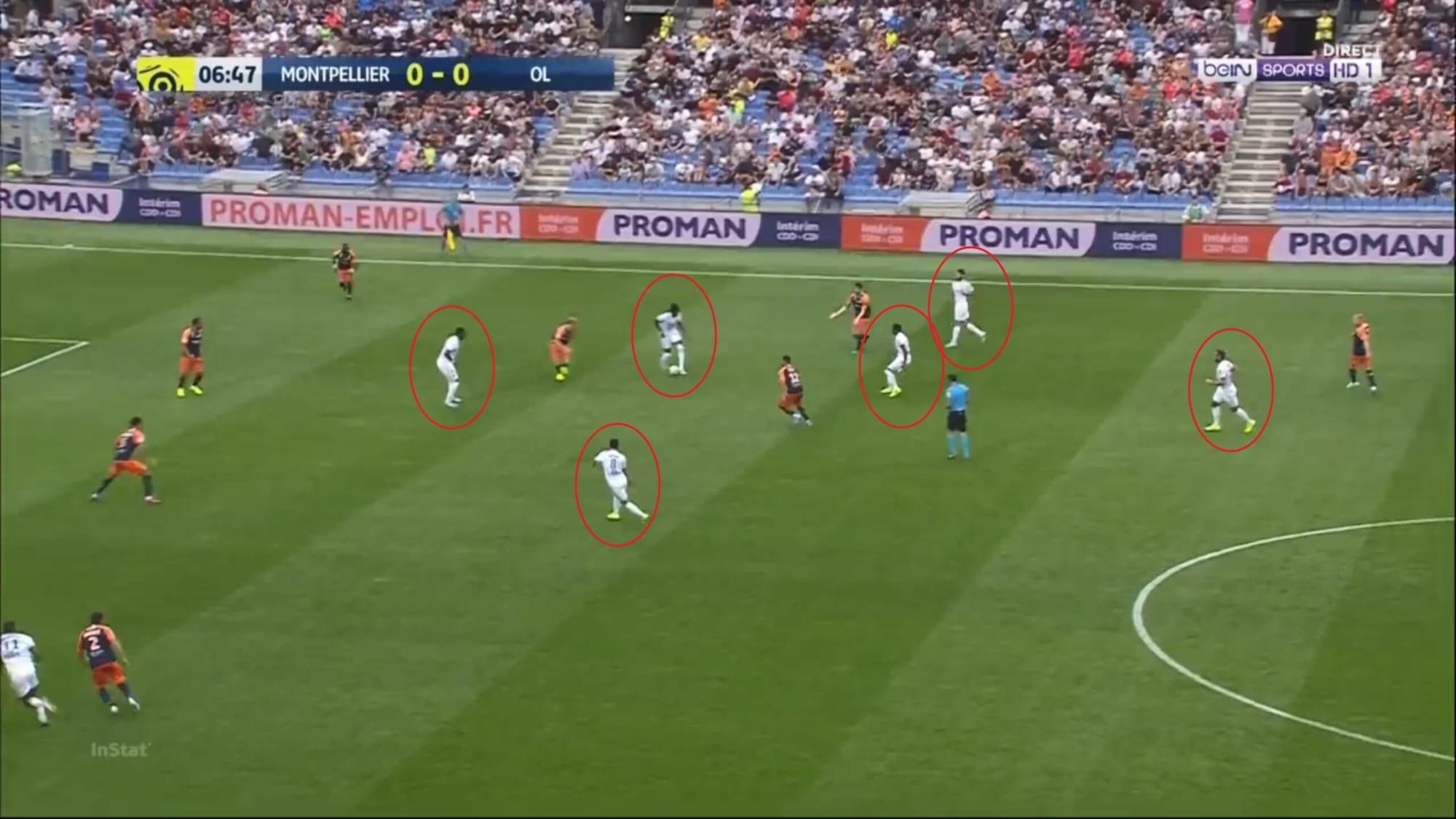
Lyon also tried to create an offensive overload on the flanks and they seemed to be extra dangerous when this situation was created, exchanging unstoppable yet accurate one-two touch passes which usually produced a breakthrough either on the flanks or centrally. However, this was rather inconsistent and happened a number of times on the right side of the flank, but much scarcer on the left-wing.
In this situation, we can see Dembele dropping slightly deeper and moving to the half-space. Aouar and Mendes closed down Traoré to provide passing options while Dubois made an overlapping run to provide width. Tousart also moved up to support the attack.
Conclusion
The affair was cagey for most parts of the first half, but Souquet’s rocket in the 42nd minute opened up the game a bit. Both teams started exchanging attacks, but it was quite clear that Montpellier were the better side tactically.
Montpellier were well-prepared and knew what was coming and dealt with their opponents properly. Meanwhile, Lyon looked clueless and confused. Their main game plan was squashed rather easily by their opposition and they never really seemed to find the plan B.
The 1-0 home win for Montpellier was well-deserved and everyone associated with the club should definitely be happy with the result. Lyon were not easy to defeat but Montpellier got the edge due to some brilliant tactical play.

If you love tactical analysis, then you’ll love the digital magazines from totalfootballanalysis.com – a guaranteed 100+ pages of pure tactical analysis covering topics from the Premier League, Serie A, La Liga, Bundesliga and many, many more. Buy your copy of the August issue for just ₤4.99 here.

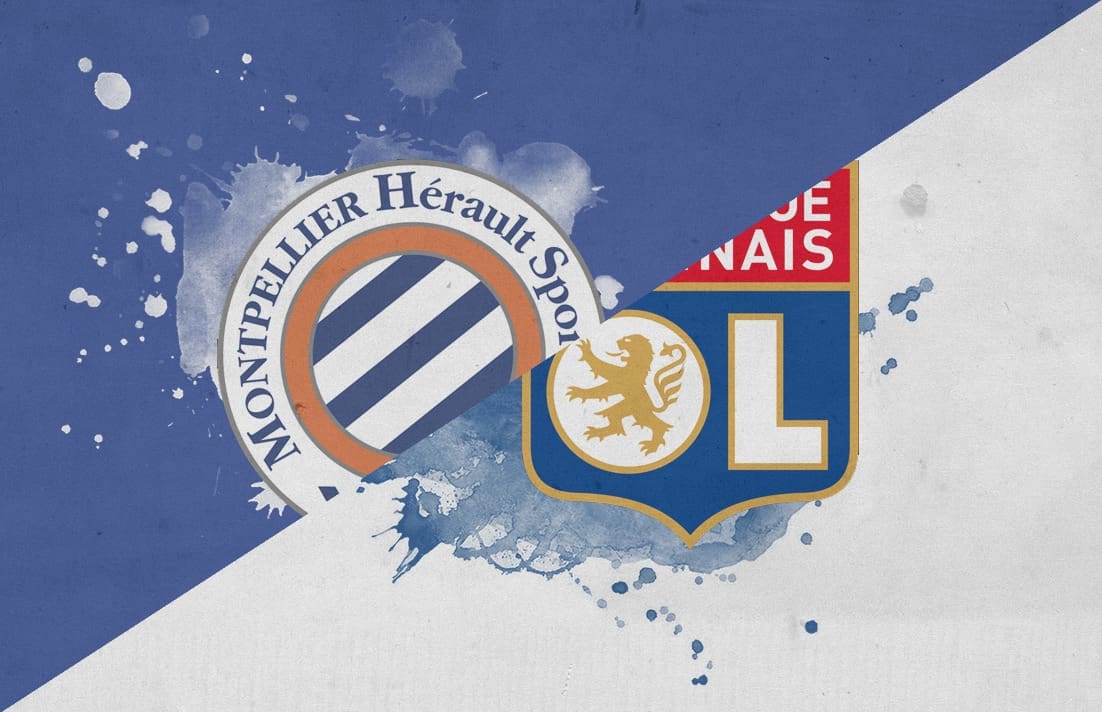



Comments